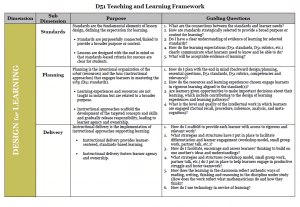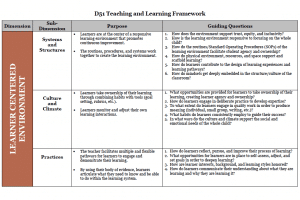An Update on D51: The Teaching & Learning Framework
CompetencyWorks Blog
 When I visited D51 a year ago, they were in the midst of developing a teaching and learning framework. I was inspired by the participatory process and intrigued with the way the framework was being developed to spark dialogue rather than simply check the boxes.
When I visited D51 a year ago, they were in the midst of developing a teaching and learning framework. I was inspired by the participatory process and intrigued with the way the framework was being developed to spark dialogue rather than simply check the boxes.
At iNACOL17, I reconnected with Rebecca Midles, Director of Performance-Based Learning, and was thrilled to meet Leigh Grasso, Executive Director of Academic Achievement & Growth. They mentioned they had completed the Teaching & Learning Framework (T&L) and were willing to share it with CompetencyWorks readers.
The purpose of the T&L Framework is to guide professional dialogue and reflection on how educators engage with students and with each other. If you remember from the D51 strategy, they are using an intentional process to support adult learning and avoid creating any high-stakes situations until teachers have been fully supported in developing their knowledge and skills in the Framework.
The Framework is organized around four interrelated dimensions: Professional Engagement, Design for Learning, Learner-Centered Environment, and Monitoring Learning. Each dimension has three sub-dimensions with several purpose statements and the powerful guiding questions.
Dimension: Professional Engagement

Professional engagement is organized around three roles of educators as learners: as a reflective practitioner, as a member of a learning communities, and as a learning system practitioner. This strikes me as an enormous step away from traditional ways of thinking about professional development and toward the type of professional learning that we hear about in Finland and New Zealand. When we talk about competency-based education, we try to emphasize that it requires establishing a culture, structure, and practices that contribute to a learning organization. This is very, very, very different from an organization based on top-down management and compliance.
Dimension: Design for Learning

By calling this dimension Design for Learning, D51 is asking educators to think differently about their job. From focusing solely on instruction and curriculum, educators are now designers. Yet the three sub-dimensions sound similar to what you might expect in any schools: standards, planning, and delivery.
D51 is starting with the Colorado standards as their learning targets. Some districts spend time in their first year reorganizing around competencies and clarifying how they relate to the state standards. D51 chose to put their energy in the first year of implementation into building a strong foundation of growth mindset and social & emotional learning, and began with the Colorado standards as their learning targets. The emphasis on standards as explained in the purpose is that learning experiences are designed with “the end in mind” and that “criteria for success are clear for students.”
The questions under planning and delivery are highly related to each other, taking into consideration building student ownership, productive struggle, differentiation, and engagement strategies. These are all great prompts, and they open the door toward deeper conversations among educators about strategies to respond to students.
My personal lessons learned through the participatory process of the National Summit on K-12 Competency-Based Education suggest that this section could be enhanced with more explicit attention to equity strategies. D51 has integrated UDL into the framework and literacy across the curriculum is embedded in rubrics. However, prompting educators to be more intentional about cultural responsiveness and other equity strategies helps everyone to share responsibility for equity within a district.
However, even writing that makes me return to my conclusion several years ago that the profession of teaching is the most intellectually demanding job in the world. There is so much to know about children, about the learning sciences, about instruction, about designing learning experiences, about academic domains, about specific learning disabilities, about trauma and how to respond to children who are traumatized, about engagement and motivation, about… about… about… There isn’t any way that one teacher is going to have expertise in everything. The implication is that schools need to formally audit and manage their expertise across the district and school and how they are tapping into it.
All of this is to say, D51 has outlined the core purpose and reflective questions for the core processes of designing learning. It is easy to imagine a fourth column for advanced guiding questions for designing learning with schools managing their capacity so that enough teachers have the advanced skills to serve their student population effectively.
Dimension: Learner-Centered Environment

At D51, being able to create a learner-centered environment is an important part of what teachers do each day. The three sub-dimensions – systems & structures, culture & climate, and practices – outline the very core of operationalizing personalized learning and creating the conditions to help students build the skills to own their education.
The first question for thinking about the systems and structures is How does the environment support trust, equity, and inclusivity? I want to take a second here to highlight the importance of trust, equity, and inclusivity, as I’ve had several people question our emphasis at CompetencyWorks on embedding equity and equity strategies into the core of our understanding of competency-based education. Children need to feel safe, respected, and that they belong in order to learn. By lifting up equity, we also remind ourselves that we have a responsibility to be on guard for implicit bias, attribution error, and structures that may reinforce inequity or send signals to students that they aren’t valued. Thus, embracing equity strategies is an essential ingredient to creating an environment in which students feel safe, respected, and valued.
The sub-dimension of culture and climate focuses on student agency. The more I visit schools, the more I realize that the strategies to build student agency (or some now think about it as autonomy) are central to personalizing learning for the benefit of engaging and motivating students, as a process of becoming an independent learner with a full set of lifelong learning skills, and as an important part of making a personalized, competency-based system operational. D51 emphasizes that students need habits, tools, and understanding of their learning process in order to take ownership.
Dimension: Monitoring Learning

We all use the phrase monitoring learning, but there is a problem when the definition only means to observe or check something but doesn’t include the second step of responding to what we have observed. At D51, the sub-dimensions of assessment, feedback cycle, and recording & reporting seek to explicitly define monitoring as three steps: checking (assessment), responding (feedback), and communicating (reporting).
The section on assessment defines four important elements of competency-based education. First, assessment is aligned with the learning standards. Second, assessment is transparent and understandable to students. It is part of their cycle of learning, not something done to them. Third, there are multiple opportunities for students to demonstrate their learning. If they aren’t able to demonstrate that they have mastered a learning target, teachers continue the cycle of instruction, and students keep practicing until they are ready to to show that they have learned it. Fourth, teachers can use different types of data and tools to assess students. The goal is to gain insight into how the student understands something, not whether they can pass a test or not.
Although much energy is placed on re-aligning and expanding the system of assessments in competency-based schools, the quality and timeliness of the feedback that educators provide to students is one of the most important aspects of teaching and learning. The guiding questions under the section on the feedback cycle are likely to be one of the most important areas of professional learning as schools move from early implementation to focusing on quality implementation.
—
The more I re-read these four dimensions, the more I realize that the guiding questions aren’t just for sparking discussion. They are examples of the rapid-fire questions that educators will eventually begin to ask themselves almost unconsciously as they master designing learning, creating learner-centered environments, and monitoring learning. D51 has unpacked expertise to make it accessible, discussable, and doable.
Thank you everyone at D51 for developing and sharing such a powerful guide for the rest of us to learn from.